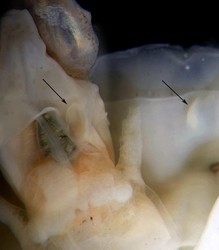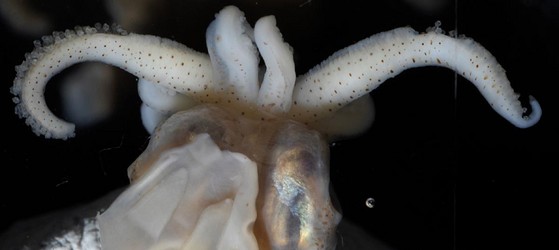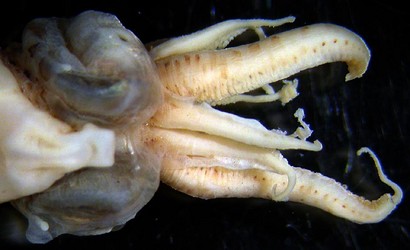

Figure. Three views of the same specimen of Magnapinna pacifica captured in the Gulf of Mexico. Left - Dorsal view of the fresh squid. Photograph courtesy of T. Frank. Middle - Dorsal view of the preserved squid. Photograph by M. Vecchione. Right - Ventral view of the preserved squid. Photograph by R. Young.
Introduction
The Atlantic specimen, exactly the same size (51 mm ML) as the holotype, was captured by Tammy Frank (Harbor Branch Oceanographic Inst.) in the Gulf of Mexico on May 14, 2006.
Characteristics
- Arms
- Proximal region of arms (ie, arms proximal to vermiform regions) subequal in size; bear two sucker series near arm base becoming 3-4 series distally.
- Vermiform regions approximately equal in length to proximal regions of arms.
 Click on an image to view larger version & data in a new window
Click on an image to view larger version & data in a new window
Figure. Oral view of brachial crown of M. pacifica, Gulf of Mexico. Photograph by R. Young.
- Proximal region of arms (ie, arms proximal to vermiform regions) subequal in size; bear two sucker series near arm base becoming 3-4 series distally.
- Tentacles
- Proximal-tentacle with 6-7 sucker series distally, 2 sucker series proximally; basal two suckers enlarged relative to following suckers in region of two sucker series.
- Proximal-tentacle with 6-7 sucker series distally, 2 sucker series proximally; basal two suckers enlarged relative to following suckers in region of two sucker series.
- Funnel
- Funnel component of the funnel/mantle locking apparatus with oval to teardrop-shaped depression. Mantle component with teardrop shape.
- Dorsal pad of funnel organ shield-shaped; ventral pad with truncated oval shape.
 Click on an image to view larger version & data in a new window
Click on an image to view larger version & data in a new window

Figure. Funnel of M. pacifica, Gulf of Mexico. Left - Ventral view with mantle cut open showing the funnel and mantle components (arrows) of the funnel/mantle locking apparatus. Right - Ventral view of the funnel organ with the funnel cut and one half folded back. Note also, the well-developed ink sac and anal valves and the small funnel valve. Photographs by R. Young.
- Pigmentation
- Counts and Measurements: See title page.
Comments
The table of measurements on the title page indicates some discrepancy in arm lengths between Atlantic and Pacific specimens. The Atlantic specimen, however, had coiled arms that are very difficult to measure. The two specimens also seem to differ in the pigmentation of the tentacles. Only the Pacific form has slightly but distinctly enlarged medial (relative to marginal) suckers on the tentacular clubs and this form appears to have slightly broader tentacles. At present, we consider these differences as having no taxonomic significance. We could find no other clear differences between the specimens.









 Go to quick links
Go to quick search
Go to navigation for this section of the ToL site
Go to detailed links for the ToL site
Go to quick links
Go to quick search
Go to navigation for this section of the ToL site
Go to detailed links for the ToL site